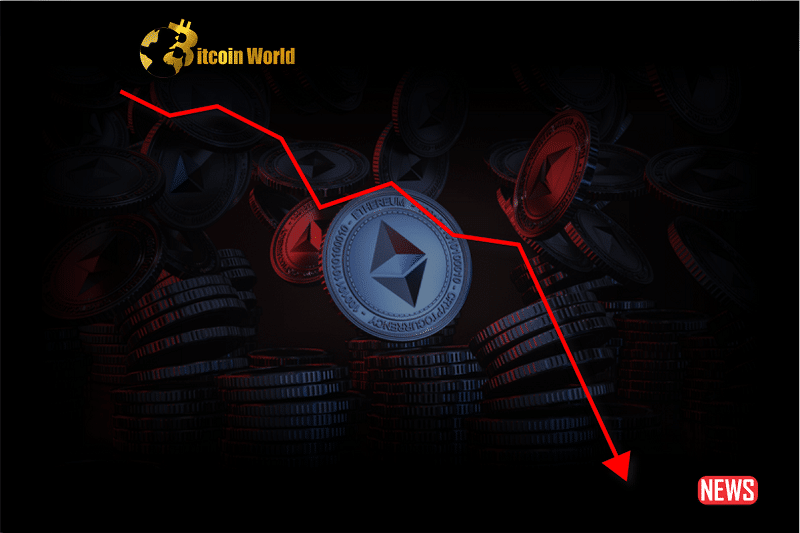Ever wondered where all the Ethereum is going? Recent data from on-chain analytics firm Nansen reveals a fascinating trend: the amount of Ethereum (ETH) held on centralized exchanges has plummeted to its lowest point in six months. As of May 8th, a staggering 26.5 million ETH, worth approximately $49 billion, remains on these platforms. This exodus raises some important questions: Why is this happening, and what does it mean for the future of ETH?
The Great ETH Migration: What’s Driving This Trend?
Several factors are contributing to this significant shift. Since the beginning of the year, the total amount of ETH traded on exchanges has decreased by nearly 10%. But a major catalyst was the collapse of FTX in late 2022. This event served as a stark reminder of the risks associated with keeping your crypto on centralized platforms, prompting many users to seek safer alternatives.
Key Drivers Behind the Declining Exchange Balances:
- FTX Fallout: The dramatic failure of FTX eroded trust in centralized exchanges, pushing users towards self-custody solutions.
- Staking Opportunities: The Ethereum ecosystem offers lucrative staking opportunities, incentivizing users to move their ETH off exchanges to earn rewards.
- DeFi Growth: The rise of Decentralized Finance (DeFi) provides various avenues for earning yield on ETH outside of traditional exchanges.
- Self-Custody Awareness: More users are becoming aware of the importance of controlling their private keys and the security benefits of self-custody.
Who Holds the Most Exchange ETH? The Big Players
While overall ETH balances are down, it’s interesting to see which exchanges still hold the largest shares. According to Nansen’s data:
| Exchange | Percentage of Total Exchange ETH | Approximate ETH Holdings |
|---|---|---|
| Coinbase | 31% | 7.91 million ETH |
| Binance | 19% | 4.78 million ETH |
| Bitfinex | 8.3% | N/A |
Coinbase currently holds the lion’s share of exchange-held Ethereum, followed by Binance. Bitfinex holds a significant, though smaller, portion.
Beyond Trading: Where is the ETH Going?
With so many ways to potentially profit within the Ethereum ecosystem, letting your ETH sit idle on an exchange isn’t the most efficient strategy for many. Nansen’s data highlights that a significant portion of the withdrawn ETH has been transferred to self-custody addresses and staked addresses. This signifies a shift from simply holding ETH for potential price appreciation to actively participating in the network.
The Shapella Upgrade: Did it Trigger a Sell-Off?
The highly anticipated Shanghai (Shapella) upgrade, which enabled the withdrawal of staked ETH, sparked concerns about a potential surge in selling pressure. However, data from Glassnode suggests otherwise. Their analysis of the 1.55 million ETH withdrawn from the Beacon Chain reveals that there wasn’t a substantial increase in exchange inflows post-upgrade.
Initially, there was a spike in withdrawal requests, but this quickly stabilized. Currently, stake exits remain relatively consistent, ranging between 300 and 700 daily.
Kraken’s Exit and Lido’s Rise: Staking Landscape Shifts
Interestingly, Kraken accounted for roughly 32% of all ETH withdrawals. This was largely due to an enforcement action by the SEC that led to the termination of their staking services. While Kraken saw significant withdrawals, Lido, a liquid staking solution, has emerged as a major beneficiary of the Shapella upgrade, despite not directly supporting withdrawals.
Key Takeaways from the Shapella Upgrade Impact:
- No Major Sell-Off: Fears of a massive sell-off after the Shapella upgrade have not materialized.
- Kraken’s Withdrawal Impact: SEC action against Kraken significantly contributed to withdrawal volumes.
- Lido’s Dominance: Lido has significantly increased its market share in the staking landscape.
Currently, Lido commands a 33.5% market share in the staking sector, with Coinbase following in second place at 11.5%. Glassnode’s researchers concluded that the Proof-of-Stake mechanism for both entering and exiting validators has functioned as intended, maintaining the stability of Ethereum’s consensus.
Price Action: What Does it All Mean for ETH?
Despite the relatively muted selling pressure following the Shapella upgrade, ETH’s price has experienced a slight pullback, mirroring the broader market trends. At the time of writing, ETH is trading around $1,842, down 1.2% on the day. While it briefly flirted with the $2,000 mark recently, it encountered significant resistance. ETH is currently down 13.4% from its 2023 high and a considerable 62.2% from its all-time peak. Short-term support appears to be holding just above the $1,800 level.
The Bottom Line: A Maturing Ethereum Ecosystem
The decreasing ETH balances on centralized exchanges signal a maturing Ethereum ecosystem. Users are increasingly opting for self-custody and engaging in activities like staking, indicating a long-term investment mindset and a growing confidence in the network’s security and potential. While price fluctuations are inevitable in the crypto market, the underlying trend of ETH moving off exchanges points towards a fundamental shift in how holders are interacting with the asset. This exodus reflects a growing understanding of the benefits of self-sovereignty and active participation in the Ethereum network, suggesting a potentially stronger and more decentralized future for ETH.
Disclaimer: The information provided is not trading advice, Bitcoinworld.co.in holds no liability for any investments made based on the information provided on this page. We strongly recommend independent research and/or consultation with a qualified professional before making any investment decisions.


